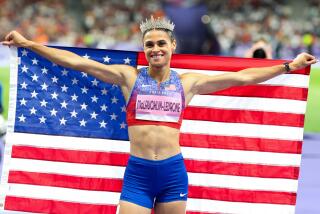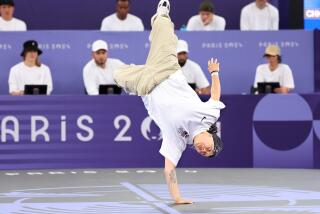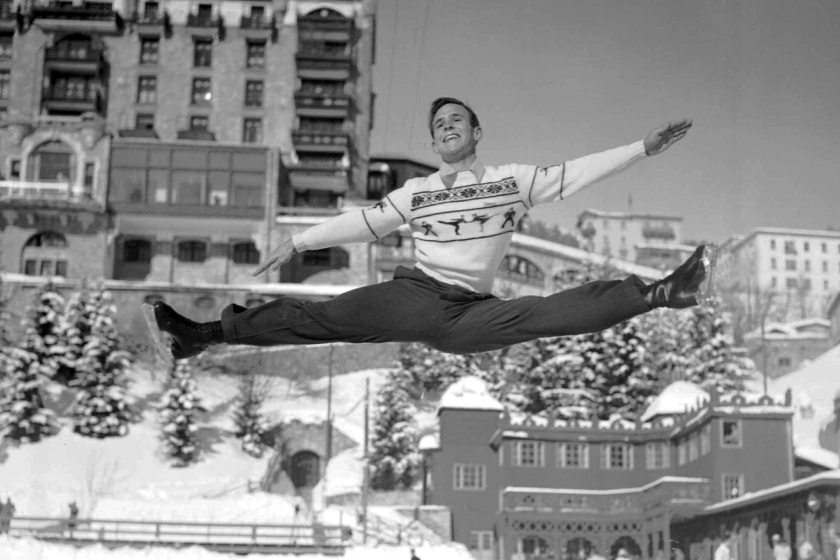Fast Forward
- Share via
ATHENS — Outside the rented hall where a shoe company is paying its athletes to meet the press, journalists are lined up like shabbily dressed night-clubbers, waiting for the bouncer to open the door.
A British writer, either fishing for an angle or simply trying to kill time, asks a few American colleagues about the popularity of Michael Johnson back in the States.
“After Michael Jordan, he’s the most popular athlete you have, no?”
Well, now that you mention it . . . no.
After Michael Jordan there’s Tiger Woods, the British scribe is told.
Then the entire NFL.
Then Shaquille O’Neal and the rest of the NBA.
Then Ken Griffey Jr. and some of the bigger names in baseball. Maybe throw a couple hockey players in there too.
The American writers huddle.
They finally decide Johnson is probably the United States’ best-known Olympic athlete--give or take a female figure skater or two--and, as such, ranks on the American household-name scale somewhere in the same vicinity as the mid-level drivers in NASCAR.
The British writer shakes his head, seeming incredulous, or disturbed, maybe a little of both.
Buck up, the Americans tell him--”At least now, after Atlanta, most Americans know what Michael Johnson does.”
Sad but true, U.S. track and field circa 1997 thrives only as an off-shore industry, fascinating European and Asian enthusiasts with tales of amazing achievement and times of 19.32 seconds in the 200 meters, but is largely ignored on home soil.
Americans can appreciate fast running, but to appreciate a fast runner, you have to give him more than a glower in a Nike television ad. Americans want personality too--be it Magic warm or Rodman weird--and as point man for his sport, Johnson strikes so many as cold and aloof that the Carl Lewis era is starting to receive the good-old-days treatment.
That was one reason the line outside that rented hall on the outskirts of Athens was so long Thursday night.
Inside, nervously awaiting her turn at the microphone, was Marion Jones, already christened as the next and maybe last hope U.S. track has at expanding its fan base at home beyond its current fringe status.
Because she runs fast and jumps far, Jones has been called the Next Carl Lewis.
Because she is tall, slender and photogenic, she has drawn comparisons to Florence Griffith Joyner and Wilma Rudolph.
Because she is a long jumper-sprinter with a background in basketball, she has been designated heir apparent to Jackie Joyner-Kersee.
Because she won the 100 meters and long jump at last month’s U.S. championships, and has a reasonable chance at three gold medals here at the IAAF World Championships, she is regarded as the onrushing future of American track and field, about to break out on the global stage in the next nine days.
That is quite a weight to hang on the shoulders of a media-shy 21-year-old, but Jones has only herself to blame.
After running the second-fastest women’s 100 meters in the world this year--10.90 seconds, just behind Gail Devers’ 10.89--and soaring 22 feet 9 inches in the long jump to dethrone Joyner-Kersee at the national championships in Indianapolis, Jones created this predicament entirely by her own doing.
“I think Marion Jones is just the answer to the ‘Track is dead’ [in the United States] talk,” U.S. sprinter Jon Drummond says. “She’s the answer to the question, ‘Are there any more runners in the U.S.?’
“Marion comes from maybe the last era when kids in this country were devoted to the sport of track, kids who ran because they loved to. Kids today want to get high, get drunk, smoke, listen to music and gang-bang. They don’t want to compete.
“Marion is young enough where maybe she can make a difference. She could be the last one to step up to the line and with her physicality--I don’t know if that’s the word for it, but I’m using it anyway--show kids today what’s possible if they put their minds to it.
“Maybe some kid out there sees Marion doing these things and winning these medals and says, ‘Hey, I can do the same thing.’ That’s why it’s important she continues.”
To continue or not continue--that has long been the rub with Jones.
She has frustrated U.S. track officials and fans when her aspirations haven’t always matched her sprint clockings, seeming too often to be a basketball player first and foremost and a runner, essentially, as a hobbyist.
As a 16-year-old junior at Thousand Oaks High, Jones earned a spot on the 1992 U.S. Olympic team as a relay sprinter--but declined the invitation, claiming she was too young.
She then enrolled at the University of North Carolina to play basketball, starting as a freshman point guard for the 1993-94 Tar Heel team that won the NCAA championship.
A basketball injury, a broken foot, prevented Jones from qualifying for the 1996 Olympics and curtailed her progress on the track until she finally made a decision to stop the moonlighting this spring.
She played out the 1996-97 basketball season with the Tar Heels, then announced she was bypassing her senior season to concentrate on track.
Within weeks of that announcement, Jones became a double champion at the U.S. nationals.
“For the first time, I got the chance to focus on one thing in my life,” Jones says. “For the past four years, I’ve had school, I’ve had basketball, and I’ve had track and field. For the first time, over the past 16 weeks, I’ve had only one thing to concentrate on and try to be successful in. . . .
“In high school, I did both sports and, when I got to college, I thought I could do both sports and be successful. But at this level, I now know that a lot more training is involved.
“I didn’t want to give up basketball, but last year watching the Olympics on television really motivated me to get back to my first true love.”
Single-minded at the moment, Jones could well be triple-medaled in Athens. She will compete in the 100 meters, the long jump and will run the second leg of the favored U.S. women’s 400-meter relay team.
With Devers entered only in the relay, Jones’ primary competition in the 100 will be Jamaica’s Merlene Ottey, who, at 37, will be giving away 16 years to Jones.
Competition in the long jump will be steeper, the field including Joyner-Kersee, 1995 world champion Fiona May of Italy and Lyudmila Galkina of Russia. Jones’ leap of 22-9 at Indianapolis was best in the world this year before Galkina jumped 22-10 3/4 in late June.
Three gold medals at the World Championships?
Riding to the rescue and saving U.S. track and field from itself?
The agenda is an overload, even from someone who has flatly assessed, “In my mind, I am the world’s fastest woman.”
At Indianapolis, Jones cautioned against too much expectation too soon when she backpedaled out of the Next Carl Lewis discussion.
“It’s a great comparison,” Jones said. “But my name is Marion Jones, not Carl Lewis.”
Marion Jones, in track spikes and body suit, with no distracting basketball hoop in sight, ought to be enough for the moment.
Even if she does sneak a peek at the WNBA and ABL on television on occasion.
“I’m going to sit back and see how the leagues do,” Jones says. “Maybe way, way down the road, I’ll perhaps venture back to my other love. But right now I’m definitely focused on running.”
To put it another way, for the benefit of the American sports fan, as Jones steps into the starting blocks for today’s first 100-meter preliminary heat . . .
She’s got next.
(BEGIN TEXT OF INFOBOX / INFOGRAPHIC)
World Outdoor Track and Field
Championships
* WHERE: Panathinaikon Stadium, site of the first modern Olympics in 1896, Athens.
* WHEN: Competition today through Aug. 10.
* TV: Today, Sunday, Channel 4.
* COMPETING: 200 countries, three more than at 1996 Olympics; record 1,957 athletes are entered.
* PRIZE MONEY: Individual winners receive $60,000; $30,000 for second; $20,000 for third. Winning relay teams will divide $80,000; $40,000 for second; $30,000 for third.
* BONUS: Anyone breaking a world record will win $100,000.
* KEY EVENTS: Today, men’s shot put final; Sunday, men’s and women’s 100-meter final; Monday, women’s 400-meter final; Tuesday, men’s 400-meter final; Wednesday, men’s high jump final, men’s 1,500-meter final; Thursday, men’s 110-meter hurdle final; Friday, men’s and women’s 200-meter final; Aug. 9, women’s long jump final; Aug. 10, men’s 4x100 relay final.
More to Read
Go beyond the scoreboard
Get the latest on L.A.'s teams in the daily Sports Report newsletter.
You may occasionally receive promotional content from the Los Angeles Times.






